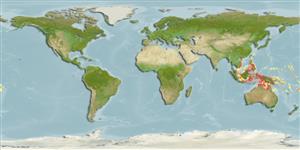Actinopterygii (ray-finned fishes) >
Perciformes (Perch-likes) >
Sciaenidae (Drums or croakers)
Etymology: Nibea: Greek, niba, nipsis = to wash.
Environment / Climate / Range
Ecology
Marine; freshwater; brackish; benthopelagic. Tropical, preferred ?
Western Central Pacific: New Guinea and northern Australia.
Size / Weight / Age
Maturity: Lm ? range ? - ? cm
Max length : 65.0 cm SL male/unsexed; (Ref. 44894); common length : 50.0 cm SL male/unsexed; (Ref. 9772)
Short description
Morphology | Morphometrics
Dorsal
spines
(total): 11;
Dorsal
soft rays
(total): 27-31;
Anal
spines: 2;
Anal
soft rays: 27 - 31. Snout blunt, obtusely rounded, slightly projecting in front of upper jaw; mouth small, inferior; upper jaw extending backward below hind margin of pupil, upper jaw length 31-38 % of head length, lower jaw length 34-40 % of head length, lower jaw length 34-40 % of head length. Mental pores in 3 pairs, the first close together, united by a crescent-shaped groove just behind symphysis. Teeth differentiated into large and small in upper jaw only; the; large ones closely spaced, not canine-like, forming outer series; a band of villiform teeth on lower jaw. Second anal spine long, stiff, 38-64 % of head length, progressively thicker with age and size. Lateral line scales numerous, 57-60. Swim bladder carrot-shaped, with about 18 pairs of fan-like appendages along its sides, the first pair entering head beyond transverse septum. Sagitta with a tadpole-shaped impression, the tail of which is J-shaped.
Occurs in shallow coastal waters, estuaries and in freshwater as far as 500 km upriver from the sea (Ref. 9772, 44894).
Life cycle and mating behavior
Maturity | Reproduction | Spawning | Eggs | Fecundity | Larvae
Sasaki, K., 1992. Two new species of Nibea (Sciaenidae) from northern Australia and Papua New Guinea. Jap. J. Ichthyol. 39(1):1-7. (Ref. 10324)
IUCN Red List Status (Ref. 115185)
CITES (Ref. 94142)
Not Evaluated
Threat to humans
Harmless
Human uses
Fisheries: commercial
More information
Common namesSynonymsMetabolismPredatorsEcotoxicologyReproductionMaturitySpawningFecundityEggsEgg development
Age/SizeGrowthLength-weightLength-lengthLength-frequenciesMorphometricsMorphologyLarvaeLarval dynamicsRecruitmentAbundance
ReferencesAquacultureAquaculture profileStrainsGeneticsAllele frequenciesHeritabilityDiseasesProcessingMass conversion
Tools
Special reports
Download XML
Internet sources
